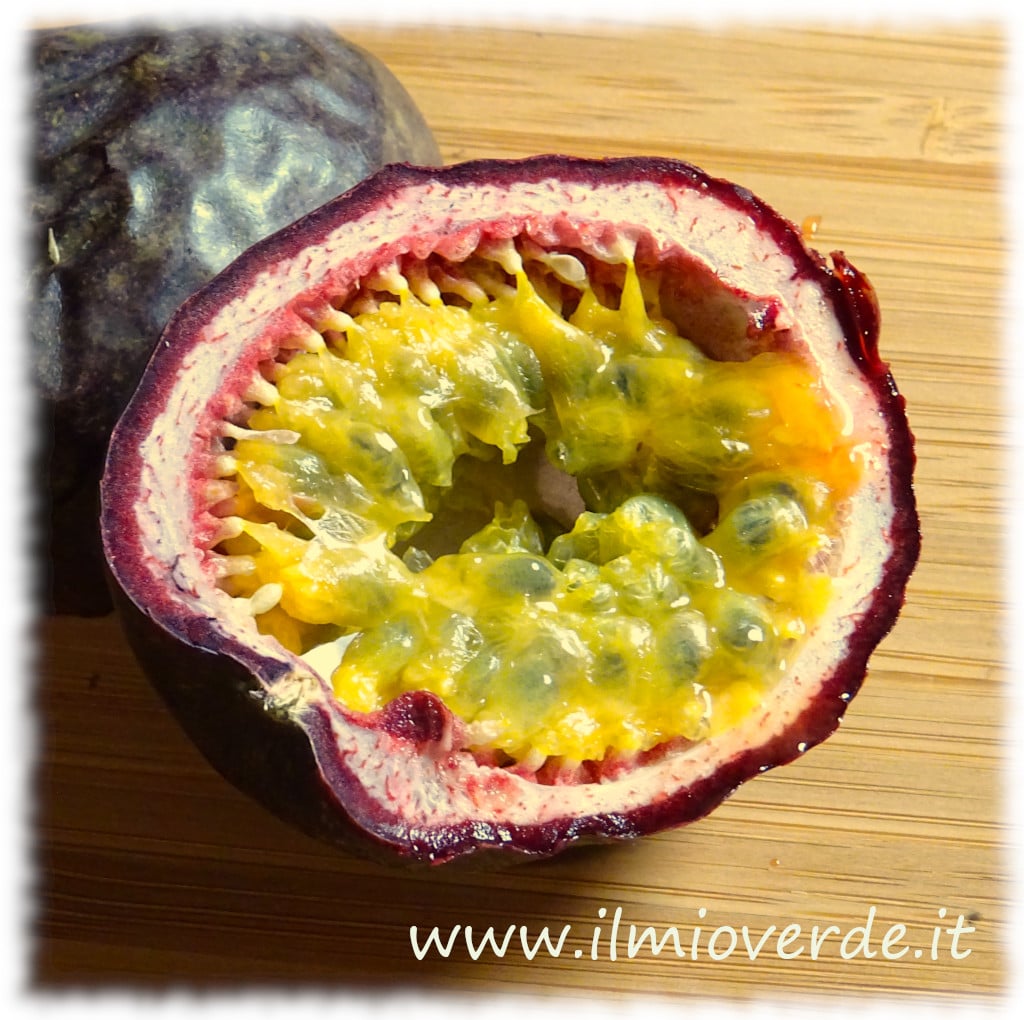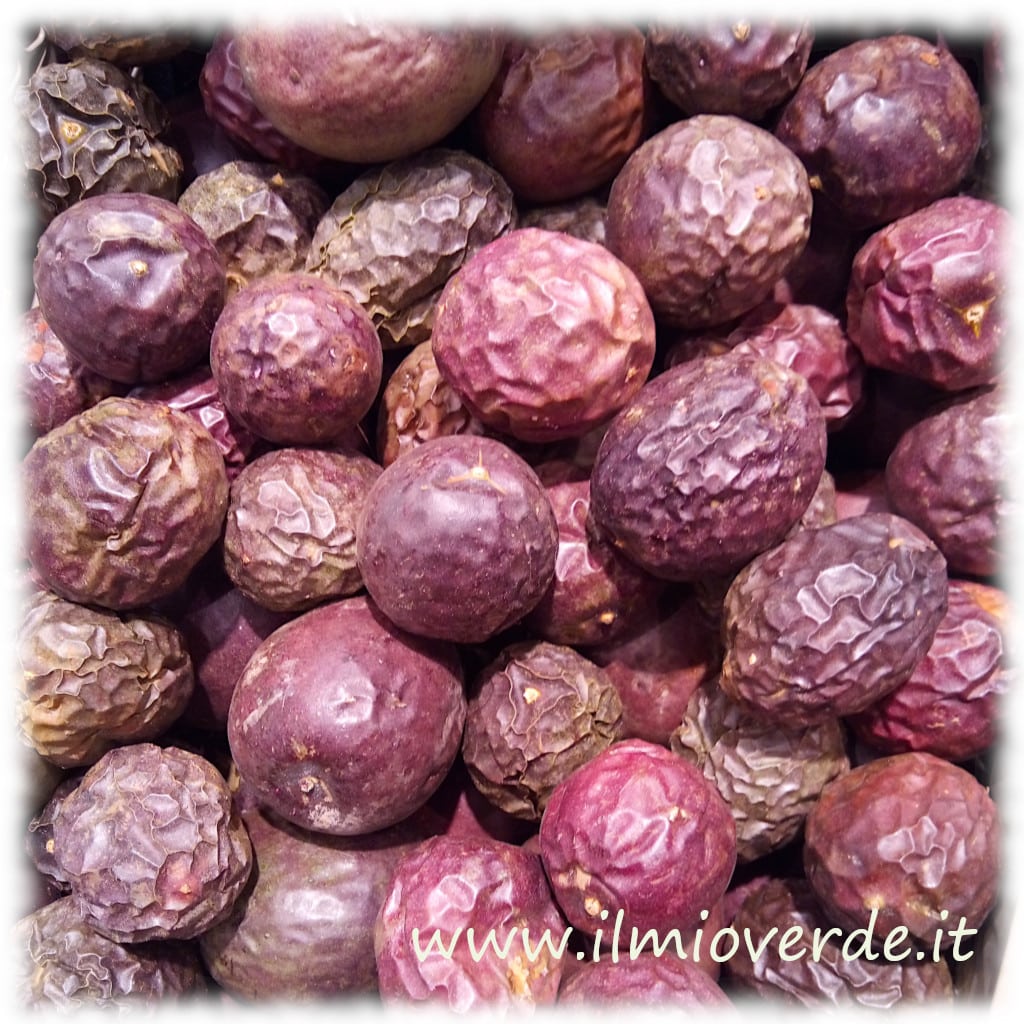Passiflora edulis
Passiflora edulis, commonly known as passion fruit, derives its name from the symbolic association made by Christian missionaries between the complex structure of its flower and the Passion of Christ. Native to South America, it quickly spread to other tropical and subtropical regions due to its unique flavour and medicinal properties.
Description
Passiflora edulis is a perennial climbing plant, characterised by flexible vines and bright green lobed leaves. Its flowers are spectacular and ornamental, featuring a combination of colours ranging from white to purple. The fruit is a round or oval berry, with a thick skin that is dark purple or yellow, depending on the variety.

A Fruit for True Enthusiasts
Passion fruit is often considered a delicacy for true connoisseurs. Although the pulp is delicious and full of flavour, the edible portion is much smaller compared to other fruits. This makes it a particular choice for those who appreciate intense flavours rather than abundance.
Characteristics
The fruit is known for its yellow, juicy pulp, rich in edible seeds. Its flavour is a mix of sweet and tart, with a strong tropical aroma. The plant grows quickly and produces abundant fruit under ideal conditions.
Flowering
Flowering generally occurs in spring and summer, but in favourable climates, it can extend for most of the year. The large, beautiful flowers attract pollinators like bees and butterflies.
Climate and Exposure
It prefers a mild or tropical climate, with temperatures ranging between 20 and 30°C. The plant cannot tolerate prolonged frost but can be grown in pots in colder regions and protected in winter. It needs full sun exposure to grow vigorously and produce abundant fruit. It can tolerate partial shade, but fruit production may be affected.
Soil and Watering
It requires well-drained, organic-rich, slightly acidic soil, with a pH between 6 and 6.5. It is important to keep the soil consistently moist, but not waterlogged. During hot periods, more frequent watering is necessary.
Fertilisation
It is advisable to use a balanced fertiliser with a slight potassium preference to encourage flowering and fruiting.
Propagation
Passiflora edulis can be propagated from seeds or cuttings. The seeds should be fresh and can be planted in a light substrate. Cuttings, taken from young vines, root easily under controlled humidity conditions.
Care and Tips
It is a hardy plant but can be attacked by pests such as aphids and mites. Regular checks and, if necessary, the use of biological remedies are recommended. Common diseases include root rot, caused by poor drainage, and fungal infections. Good cultural practices are essential to prevent them.
Culinary Uses
Passion fruit pulp is used in many recipes, from desserts to juices. It is a key ingredient in mousses, ice creams, and cocktails due to its exotic and refreshing flavour.
How to Sow Passiflora edulis?
If you have a passion fruit and want to try planting its seeds to enjoy the sight of its beautiful flower, follow these instructions:
Seed Preparation
Cleaning the seeds: To ensure good germination, it is advisable to remove the gel-like pulp surrounding the seeds. You can do this by soaking them in warm water for 24-48 hours. After soaking, gently rub them to remove any pulp residue.
Treatment to promote germination: The seeds can be immersed in warm (not boiling) water for several hours to break dormancy.
Sowing
Soil: Use a mix of light, well-drained soil rich in organic matter, such as an equal mix of peat and sand.
Sowing depth: Plant the seeds about 1 cm deep.
Environmental conditions: Keep the soil consistently moist (but not soggy) and place the pot in a warm, bright location, ideally between 20 and 25°C.
Germination time: Germination can take anywhere from 10 days to several weeks, depending on environmental conditions and seed freshness.
Growth and Flowering
Time to bloom: Under optimal conditions, Passiflora edulis can start flowering about 12-18 months after sowing.
Initial care: During growth, provide a trellis or structure for the plant to climb.
Winter Protection
Mild climates: Passiflora edulis can withstand brief light frosts (down to -2/-3°C), but it is advisable to protect it with non-woven fabric.
Cold climates: In areas with harsh winters, grow it in a pot so it can be moved to a sheltered place during colder months, such as a greenhouse or a bright room.
Useful Tips
Exposure: Place it in full sun for vigorous growth and good flower and fruit production.
Watering: Keep the soil slightly moist, avoiding waterlogging.
Fertilisation: During the growing season, use a potassium-rich fertiliser to encourage flowering.
